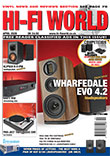|
HIGH TIMES
Conceived in the psychedelic seventies, Ambisonics was to be the future. It's time may yet come.
Our diagram shows an Ambisonic playback system with periphony (height). This would position sounds accurately above, or reproduce the acoustics of a venue correctly. It offers listeners ‘envelopment' in the original sound field. An Ambisonic recording can be processed to feed any number of loudspeakers in any arrangement, including conventional 5.1, 6.1 or 7.1 surround-sound formats. A child of the 1970s, much like Quadraphonics – as you’d guess from the name – Ambisonics is all about surround-sound. Unlike Quadraphoncs though, Ambisonics is an idea that refuses to die. The simple reason is that Ambisonics is, at heart, a powerful sound field recording scheme that even today is being looked at carefully, by the BBC for example, as a possible way ahead.
In a nutshell, one Ambisonic microphone can capture the position of all sounds around it, including height. So, it can record, for example, a singer in front of the microphone, someone yelling in the audience behind, over to the left somewhere, and a helicopter clattering overhead from rear to front (this is an open air concert!). All of them will be correctly positioned during playback in a room, so listeners will in effect be sitting where the mic was and hear the event in its sonic entirety. This is powerful stuff. As the BBC have noted it’s all but perfect for archival recordings, as it captures live a complete event. The implications for cinema audiences and the home are tremendous but, as you might guess, there are difficulties. The main one is that at least one ceiling loudspeaker is required for periphony (height information), and the more the merrier. With Ambisonics, the recording can, in theory, be mapped out to loudspeakers wherever they are; where the loudspeakers are placed and how many of them are used can be decided by the listener. A minimum of just four data channels is needed, something the BBC have available within their Freesat broadcasts. Ambisonics systems are flexible like this, but it needs a computer to calculate and then process the signal out to the loudspeakers. Today’s AV receivers do, however, listen to the room with a small, supplied measuring microphone when Audyssey room tuning, and carry out processing within on-board Sharc DSP chips (and suchlike) so this bit of the necessary infrastructure already exists. So do sound field microphones, from Calrec for example, and Ambisonic sound field recordings, from Nimbus Records for example. There are computer programmes to perform the calculations too. But because Ambisonics is an open idea around which people have studiously worked since the 1970s, and not a proprietary commercial technology, there is no agreed way of reproducing it in the home, in hardware terms at least. Our diagram shows a common arrangement for good periphony (height) and it needs an eight channel amplifier. If one overhead loudspeaker is used, this drops to five channels. It could well be that someone like the BBC, or better a group of broadcasters, could provide impetus by broadcasting an Ambisonic coded audio signal to accompany, say, live events, outdoor nature recordings and what have you. This can be mapped out to any number of loudspeakers in any arrangement, from mono to eight channels or more, with a suitable decoder. The sounds of a jungle would come from all round, with parrots squawking and monkeys calling in the trees above. It’s a powerful idea and very suited to this sort of programming. Audio could hardly go any further. At present only Meridian incorporate decoders within expensive processors, and simple decoders are not currently available. Will it ever be practicable to install height loudspeakers in the average home? Hi-fi quality ceiling loudspeakers are available for custom installation from companies like B&W so it is practicable, if not easy. A domestic electrician faces this sort of work every day, however, installing ceiling downlighters and bringing wiring down to a wall switch and supply, so whilst disruptive, fitting ceiling loudspeakers is a common enough and affordable job. Whether many people would be prepared to do it is an open question. Ambisonics was an idea from the 1970s way ahead of its time and the technology of its day. Coding a complete sound field is more than a little ambitious, but modern digital storage and transmission schemes can handle it and the whole idea may yet reach the home. For more on Ambisonics, see www.bbc.co.uk/blogs/researchanddevelopment/2010/03/audio-in-the-north-part-1.shtml Ambisonic discs are available from Nimbus Records and decoders from Meridian Audio. Height information is not available in many recordings, or necessarily via decoders. |
Search
Hi-Fi World, Powered by Joomla!; Hosted by Joomla Wired.







